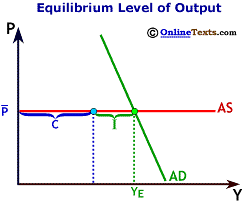
Chapter Ten: Lecture Notes -- The Fixed Price Aggregate Demand/Aggregate Supply Model
The Aggregate Supply Curve
The income-expenditure model in Chapter 9 presented a different way of analyzing the economy compared with the Aggregate Demand/Aggregate Supply model presented in Chapter 8. In this chapter, we bridge the gap between the two models, employing the fixed-price assumption from the income-expenditure model, but using the framework of the Aggregate Demand/Aggregate Supply model.Students may find that the fixed-price Aggregate Demand/Aggregate Supply model is easier to understand than the income-expenditure model, and we will employ this framework in later chapters, but the important point is that these models present essentially identical concepts in different ways.

Because we assume that the price level is fixed, the fixed-price Aggregate Demand/Aggregate Supply model is appropriate for the very short run, or when the economy is in recession and resources are not fully utilized. Under this scenario, firms produce whatever level of output is demanded at the fixed price level. The figure titled "Fixed-Price Aggregate Supply Curve" plots the Aggregate Supply curve, which is perfectly horizontal at the fixed price level, PA.
The Equilibrium Level of Output
Because the Aggregate Supply curve is horizontal, the intersection of the Aggregate Demand and Aggregate Supply curves depends only on the placement of the Aggregate Demand curve. The level of Aggregate Supply simply responds to the level of final goods and services demanded. Put another way, suppose that you are the owner of a firm that lays fiber optic cables. Demand for your product increases. You respond by increasing output; the price you charge is unchaged. This model assumes that all firms respond this way to an increase in demand.Because output responds passively to Aggregate Demand, we need only compute the level of Aggregate Demand to determine the level of output. We looked closely at Consumption and Investment in the previous chapter; we leave Government expenditures for a later chapter.
Recall that consumption was determined primarily by disposable income, and Investment was derived from the interest rate. As interest rates fall, Investment rises. Using the familiar equations we learned from Chapters 8 and 9, we write
AD = C + I, and in equilibrium
AS = AD = C + I, so
AS = C + I.
Because Aggregate Supply always responds to the level of Aggregate Demand at the fixed price level, we know that the equilibrium level of Aggregate Supply is also the economy's equilibrium level of GDP (Y), so
Y = C + I.
Assuming that interest rates are unchanged and the level of Investment is fixed, then we only need to understand how Consumption is affected by the price level. Recall from our Aggregate Demand/Aggregate Supply model in Chapter 8 that the Aggregate Demand curve slopes downward in part due to the wealth effect. As the price level rises, the value of certain financial assets--those with returns not indexed to the price level--declines. Because people lose some of their wealth, consumption declines.

Hence, the consumption demand curve is downward sloping when the Price Level is plotted on the vertical axis as illustrated in the figure labeled "Equilibrium Level of Output." Given the price level, the horizontal summation of Consumption and Investment determines the level of Aggregate Demand, and, therefore, the equilibrium level of GDP (YE) in the economy.
Shifts in the Aggregate Demand Curve

As the figure titled "Shift of the Aggregate Demand Curve" illustrates, when the Aggregate Demand curve shifts in the fixed-price model, only output changes, prices are unchanged. This outcome is true whether the Aggregate Demand curve shifts to the right or to the left. The Fixed-Price Aggregate Demand/Aggregate Supply model is equivalent to the income-expenditure model; they are two different ways of representing the same concepts.
The basic difference is that the income-expenditure model graphs Aggregate Expenditures on the vertical axis, and the fixed-price Aggregate Demand/Aggregate Supply model graphs the price level on the vertical axis.
In future chapters, we will rely on the Fixed-Price Aggregate Demand/Aggregate Supply model to illustrate the key concepts, but the income-expenditure model could be used just as easily. If the price level does not change, then the summation of the components of Aggregate Demand gives the level of Aggregate Demand at the fixed price level.